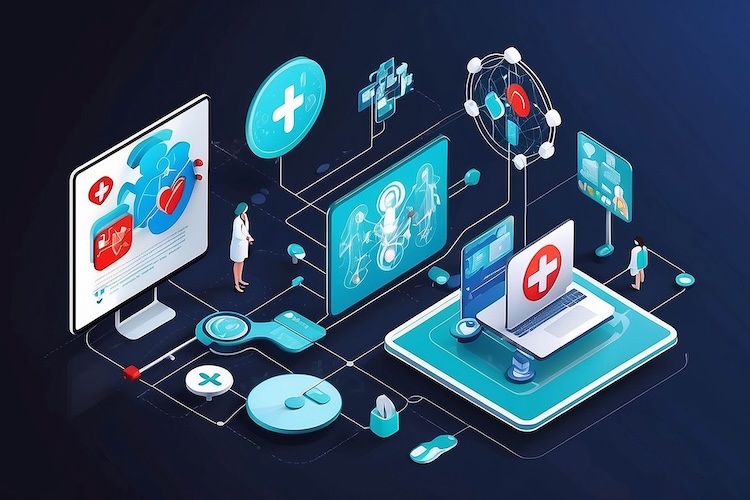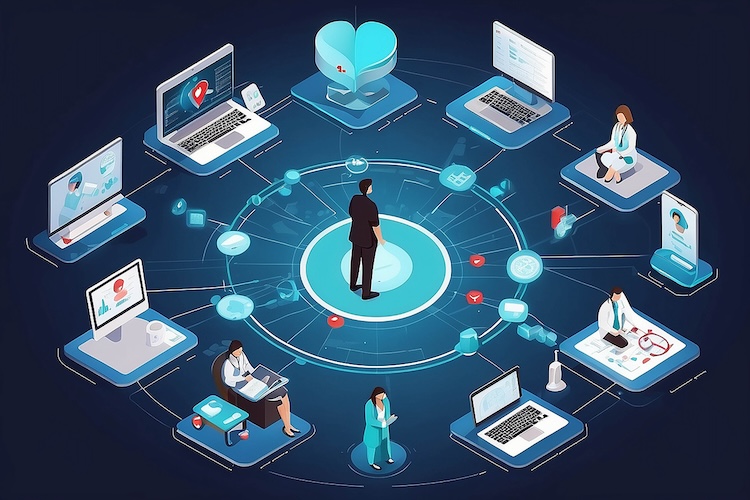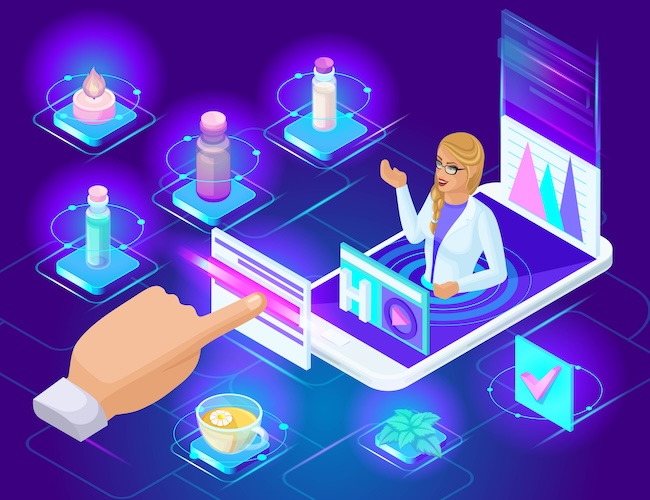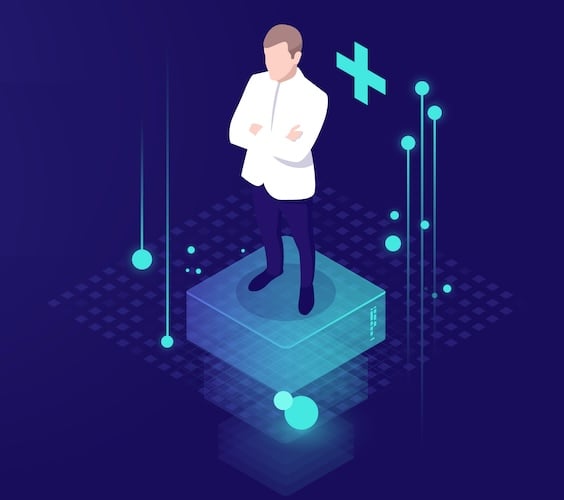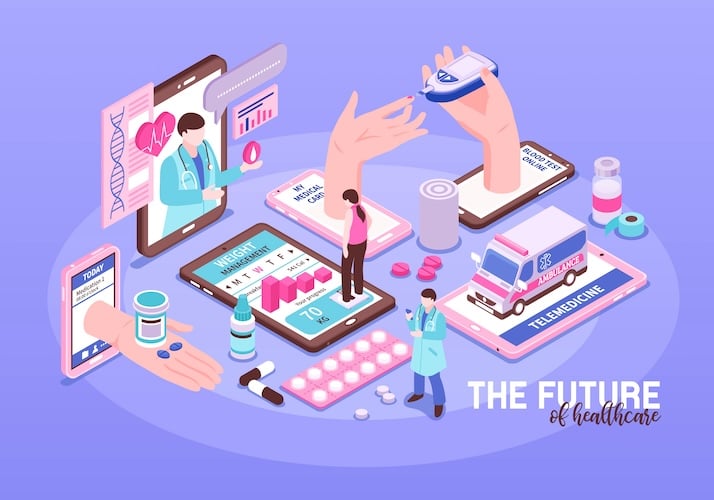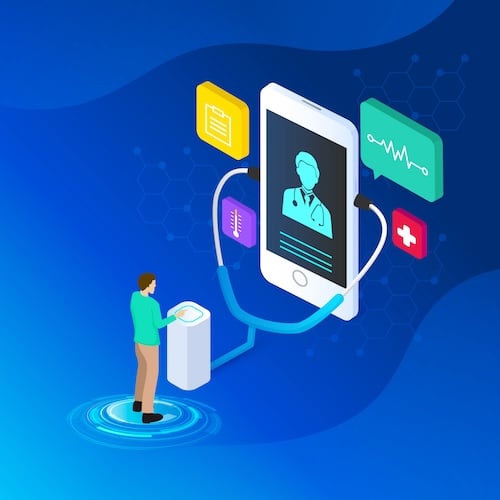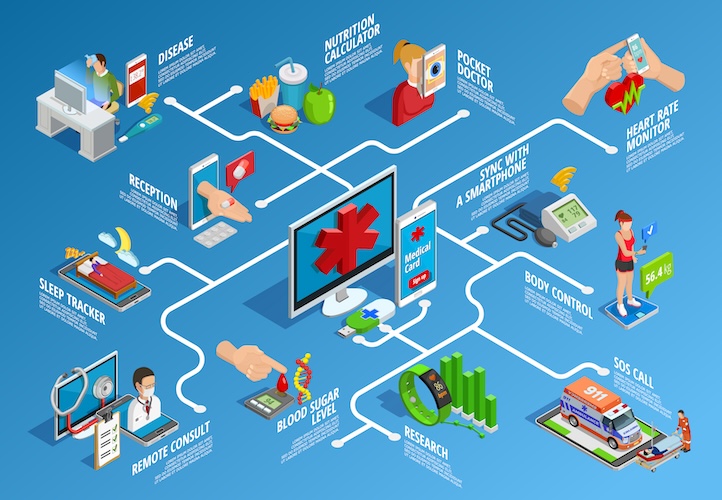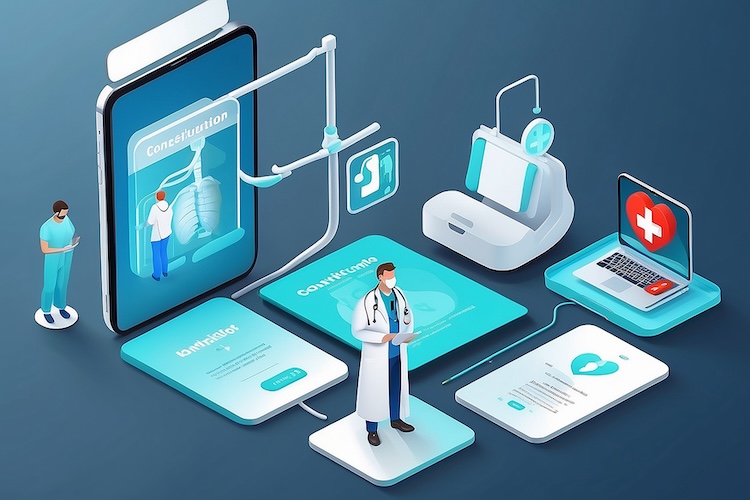It’s time to dispel the myths of web3 healthcare and look beyond the buzzwords. If you’re considering the leap into developing a web3 healthcare application, chances are you’ve already seen past the shadow of crypto scandals and market volatility. The truth is, the conversation around web3 is far richer and more nuanced than the rollercoaster headlines might suggest.
You’re not alone if you find yourself wary of the noise, wondering if the underlying web3 technologies truly hold potential to transform healthcare as we know it. But here’s the thing: visionary founders, entrepreneurs, and clinical executives like you are exactly what the healthcare industry needs—innovators unafraid to explore how blockchain can unlock new possibilities for care delivery and patient empowerment.
And while we may not all possess the diagnostic genius of Dr. Gregory House or Satoshi’s shrewdness, we don’t need to. With the right understanding and application of blockchain, anyone can contribute to redefining healthcare practices for the better. Consider this blog as your primer to a world brimming with potential, where healthcare meets innovation at the crossroads of web3 technology.
Top Takeaways:
- Web3 development in healthcare introduces the concept of blockchain technology that stands as a revolutionary force, poised to address critical challenges within the healthcare sector. It offers unparalleled levels of security, transparency, and efficiency, promising to significantly enhance data integrity, patient privacy, and streamline processes.
- Venturing into the world of web3 healthcare software development is more than just a technological leap; it’s about crafting solutions that resonate with the core needs of the healthcare sector. This innovative endeavor requires a blend of strategic planning, technical prowess, and a keen understanding of blockchain’s capabilities to truly revolutionize patient care and data management.
- With its nuanced approach to data management—offering private ledgers for controlled access and blending blockchain’s inherent security with traditional data processing for speed—web3 for healthcare is redefining patient care. It’s a delicate balancing act between maintaining transparency for trust and safeguarding patient privacy.
Table of Contents:
Quick Primer on Web3 and Blockchain in Healthcare
Web3 Development Advantages and Drawbacks in Healthcare
Demystifying Blockchain Development for Healthcare
Real-Life Examples and Use Cases of Web3 in Healthcare
How Web3 Enhances the Healthcare Industry
Tokenization in Healthcare
How to Develop Web3 Healthcare Software
- Step 1: Idea Conception and Validation
- Step 2: Closer Inspection of Technical Solution
- Step 3: Quick Proof of Concept
- Step 4: Design and Prototype an Engaging UI/UX
- Step 5: Code the Smart Contracts and the Rest of the Blockchain-Based Infrastructure
- Step 6: Code the Front End
- Step 7: QA the Whole Thing Throughout the Development Process
- Step 8: Release and Onboard Users
- Step 9: Maintain
Blockchain-Specific Development Challenges in Healthcare Web3
Future Trends and Predictions in Healthcare and Web3
Your Next Steps
Quick Primer on Web3 and Blockchain in Healthcare
In the evolving landscape of healthcare technology, the buzz around web3 and healthcare is getting louder and more compelling by the day. But what exactly does this mean for startup founders, entrepreneurs, and clinical executives venturing into the healthcare domain?
At the heart of this revolution lies the blockchain, a technology that promises to redefine how we think about data security, patient privacy, and overall transparency within the healthcare ecosystem. Here’s a quick primer on some of the foundational concepts of web3 and blockchain that are pioneering future medical solutions:
- Decentralization: Unlike traditional healthcare databases that rely on a central authority, blockchain operates on a distributed ledger system. This means information is not stored in a single location but across a network of computers, offering a new level of security and accessibility.
What this means for providers/patients: each transaction on a web3 platform (say, a new comment in a medical record) is available for all participants, and it only becomes part of the ledger (a distributed EHR) once verified and validated (electronically, in an automated way) by all (or key) participants.
- Immutability: Once a transaction is recorded on the blockchain, it cannot be altered or deleted. This feature ensures that medical records and transactions are permanent, providing an unchangeable history of patient data.
What this means for providers/patients: if robust security measures have been implemented, the info on the platform only changes when there’s consensus among all players. What we show to providers or patients is up to us (full control over the front end) but underneath all changes are meticulously logged on the chain and remain there.
- Transparency: Blockchain offers an unprecedented level of transparency as each transaction on the ledger is visible to all participants. This transparency builds trust among users, knowing that every transaction is traceable and verifiable.
What this means for providers/patients: that’s the dream, the holy grail of medicine — a fully distributed EHR platform that anyone can join and benefit from.
- Smart Contracts: These are self-executing contracts with the terms of the agreement directly written into lines of code. In the context of healthcare, smart contracts can automate processes like insurance claims, ensuring they are processed efficiently and without the need for intermediaries.
Also Read: Smart Contract Development Guide
What this means for providers/patients: smart contracts allow to automate processes on blockchains; without them, providers could only send the same bits of data back and forth, kind of like p2p Bitcoin transfers. You can send it, you can hold it, but you can’t do anything else with BTC directly on the chain. Thank God, Ethereum brought about the concept of smart contracts. They are now an integral part of virtually any distributed ledger.
The intersection of web3 and healthcare brings forth a myriad of opportunities to enhance the confidentiality, integrity, and availability of medical data. But why is there such a buzz around what blockchain offers to the healthcare sector?
For starters, web3 offers a foundation to tackle longstanding challenges such as data breaches, inefficiencies in healthcare delivery, and the lack of interoperability among different healthcare systems.
However, like any technology, it’s essential to approach web3 with a balanced view, acknowledging both its potential and the challenges it brings. As we venture further into the realm of web3 healthcare applications, understanding these key concepts will be pivotal in unlocking the full potential of what web3 and blockchain offer to the healthcare ecosystem.
Web3 Development Advantages and Drawbacks in Healthcare
The healthcare industry is ripe for innovation, and web3 healthcare companies are at the forefront of this transformation. By harnessing the power of blockchain technology, these pioneers are reimagining how we manage and interact with health data. But what sets web3 apart from its predecessor, and what are the potential hurdles? Here’s a closer look:
Reasons for Building Web3 Health Software Over Traditional Web2 Applications
If you ask any provider who read a few blogs and went to some conferences about web3, you’d immediately hear about patient-owned medical records. But let me assure you all of these benefits listed below are absolutely possible with web2 — regular web applications (like your Epic or Cerner portal) we use every day.
- Decentralization: Traditional web2 applications store data in centralized databases that can become prime targets for cyberattacks. Web3’s decentralized nature means that data, such as electronic health records, is distributed across the network, enhancing security and reducing single points of failure.
Stuck in the past with Web 2.0? Leap into the future by understanding the implications of Web 3.0 vs Web 2.0. It’s an upgrade you don’t want to miss.
- Patient-Centered: Web3 empowers patients by giving them ownership and control over their medical data. This shift from institution-centered to patient-centered models puts individuals at the heart of healthcare, enabling patients to manage who accesses their data and for what purpose.
- Immutability: Blockchain’s immutable ledger ensures that once health records are entered, they cannot be altered or deleted. This attribute enhances the trustworthiness and reliability of medical data for both patients and providers.
- Transparency and Consent: Web3 facilitates a transparent ecosystem where transactions and data access are visible and verifiable by all permitted parties. It also offers a robust framework for obtaining and managing patient consent, crucial for HIPAA compliance and ethical considerations.
This is possible only in an ideal-world situation. How about all these crypto hacks (same web3 tech under the hood) we keep hearing about? Moreso, you can still achieve all of the above with regular web applications. It’s just there’s no incentive for key players like Epic or Allscripts to make health records available to anyone freely by granting patients full ownership over their health data.
Yet, we must acknowledge that web3 technologies have this potential readily available out of the box. That’s the true beauty of blockchains.
Unique Advantages of Blockchain in the Healthcare Context
- Interoperability: Web3 technologies can help overcome the longstanding challenge of interoperability in healthcare. By using standardized protocols, blockchain can enable different healthcare systems to securely share data, improving coordination of care and patient outcomes.
Also Read: EHR Interoperability Guide
To play devil’s advocate: how long have the government and different focus groups been advocating for FHIR, SMART on FHIR and similar standards? How many healthcare apps support those interoperability protocols today? In other words, prepare for a somewhat bumpy road on the way to decentralized healthcare.
- Streamlined Processes: Decentralized, autonomous smart contracts can automate many of the tedious, manual processes currently plaguing healthcare systems, such as billing and claims processing, reducing administrative overhead and increasing efficiency.
Disadvantages of Web3 in Healthcare
While the benefits of web3 in healthcare are significant, there are also challenges and considerations to bear in mind:
- Complexity and Scalability: The technical complexity of blockchain can be a barrier to implementation, requiring specialized knowledge. Additionally, scaling blockchain solutions to accommodate large volumes of health data effectively remains a challenge (layer 2 solutions to the rescue; also batch transactions).
- Regulatory Uncertainty: The regulatory landscape for blockchain in healthcare is still evolving. Organizations must navigate uncertain regulatory waters, ensuring that their solutions comply with existing laws and standards related to data privacy and security.
- Integration with Legacy Systems: Integrating blockchain solutions with some legacy healthcare systems and workflows can be complex and time-consuming, potentially slowing down adoption.
Web3 healthcare companies are pioneering a future where healthcare is more secure, efficient, and patient-centered. However, the path forward involves navigating the complexities of blockchain technology and addressing scalability and regulatory challenges. The promise of web3 in healthcare lies not only in its ability to solve current problems but also in its potential to open up new possibilities for patient care and medical research.
Demystifying Blockchain Development for Healthcare
In the maze of digital transformation, web3 in healthcare stands out as a beacon of potential change. Yet, as with any pioneering technology, misconceptions and challenges abound. Here, we aim to clarify some common misunderstandings and shed light on what blockchain truly brings to the healthcare sector.
Understanding Access and Privacy
It’s a common myth that any medical data placed on a blockchain becomes immediately available to all. Reality check: not all blockchains are created equal. Sure, public blockchains, while transparent, are not suitable for sensitive medical records due to their open access nature (although not altogether undoable if you apply layer 2 solutions properly).
Enter private ledgers, where access is meticulously controlled and granted only to verified participants within a particular healthcare system. Take platforms like Solve.Care, for example, a blockchain platform that integrates medical records, payments, incentives and beyond but requires strict authorization for access. This level of control ensures patient privacy without sacrificing the benefits of decentralization.
Addressing Misconceptions
Real-Time Data and IoT Systems: While blockchain offers many advantages, its suitability for real-time data processing or Internet of Things (IoT) systems in telemedicine remains limited due to inherent data throughput issues. Often, the solution lies in a hybrid approach, utilizing blockchain for secure, immutable record-keeping while relying on traditional web2 layers for high-speed data transactions. It’s like duct-taping a layer 2 solution (with the consensus mechanism for authorizing data changes) to regular web infrastructure.
Recommendation: There’s basically no reason to duck-tape web3 tech to already robust enough infra that powers real-time video and audio calls. Especially if your telemedicine plans to touch AI (transcribing, diagnosing, well – anything beyond calling). Blockchains are simply not ready to handle these volumes of data in real time.
Security Beyond HIPAA Compliance: Despite blockchain’s robust security features, no system is entirely immune to breaches. Web3 solutions have faced their share of hacks, underscoring the necessity for ongoing vigilance and advanced security protocols beyond just meeting HIPAA requirements.
Recommendation: This vulnerability is caused by smart contracts. Counter measure? Extensive security audits to find possible attack points in smart contract algos. So, when working on a web3 healthcare app you will always need to consider more than just HIPAA security guidelines because web3 safety requires additional efforts.
Transparency vs. Privacy
Transparency as a Double-Edged Sword: The transparency offered by blockchain enhances trust and decision making within the healthcare sector. However, this same transparency requires careful navigation to protect patient privacy. Balancing these aspects is crucial for harnessing blockchain’s full potential in healthcare.
Like, adding a defi EHR app on Ethereum makes all medical records visible to everybody in the world. You can probably obscure the data, but what’s the point, right? If people can access all transactions and perform on-chain analysis, this adds unnecessary vulnerabilities.
Immutability and Flexibility
Immutable, But Not Inflexible: A common question arises – if blockchain is immutable, does that mean the underlying code cannot be changed? Not at all. Blockchain-based applications can and do evolve. Take UniSwap — one of the most popular decentralized crypto exchanges. Its multiple upgrades post-launch serve as a prime example. Immutability refers to the data recorded on the blockchain, ensuring its integrity. The platform, however, can adapt and grow, reflecting the dynamic needs of healthcare applications. You just swap out the underlying smart contracts for their upgraded versions.
By understanding the nuances of blockchain development, stakeholders can make informed decisions regarding the integration of web3 in healthcare. The promise of decentralized decision making, enhanced data control, and a patient-centric approach beckons a new era of healthcare delivery. Yet, success requires navigating the landscape with an eye toward both the possibilities and the pitfalls.
Real-Life Examples and Use Cases of Web3 in Healthcare
The healthcare industry is undergoing a significant transformation, thanks to innovative web3 healthcare startups. These organizations are leveraging blockchain technology to develop decentralized applications that enhance the efficiency, security, and patient-centricity of healthcare services. Here’s a closer look at some pioneering examples across various sectors of healthcare:
Decentralized Patient Records
- MedicalChain (medicalchain.com)
- Utilizes blockchain to securely store and manage electronic health records.
- Enables patients to control access to their health information.
- Facilitates secure, immediate access for healthcare providers.
Health Data Marketplaces
- Embleema (embleema.com)
- Offers a decentralized platform for patients to share their health data with researchers.
- Patients are compensated for their contributions, enhancing patient engagement.
- Aims to accelerate medical research by providing real-world evidence through blockchain.
Healthcare Payment Systems
- Avaneer Health (avaneerhealth.com)
- A blockchain-based network designed to streamline healthcare transactions.
- Reduces administrative costs and payment processing times.
- Enhances transparency and trust between healthcare organizations and payers.
Read more on healthcare payment system integration
Medical Supply Chain Tracking
- SkyCell (skycell.ch)
- Utilizes blockchain to ensure the integrity of pharmaceutical supply chains.
- Provides a secure, transparent record of shipping conditions and handling.
- Helps prevent counterfeiting and ensures compliance with healthcare regulations.
Thinking of developing a digital solution in healthcare? Discover how to make a pharmacy app that stands out, enhancing the way we think about digital health solutions.
Clinical Trials
- Triall (triall.io)
- Applies blockchain technology to manage and secure clinical trial data.
- Ensures data integrity, auditability, and transparency throughout the research process.
- Streamlines regulatory review and approval processes.
Read more on clinical trial software development and medical device clinical trials.
R&D and Decentralized Science (DeSci)
- ResearchCoin (RSC) and ResearchHub
- A platform that rewards researchers and contributors with cryptocurrency.
- Encourages sharing and collaboration within the scientific community.
- Aims to accelerate the pace of scientific discovery through decentralized incentives.
Credentialing
- ProCredEx (procredex.com)
- Delivers a streamlined process for the verification of professional credentials in healthcare.
- Reduces the time and cost associated with verifying healthcare professionals’ qualifications.
- Enhances the mobility and deployment of healthcare workforce across institutions.
Perspectives on Telemedicine and the Metaverse
For advanced web3 for healthcare products, we’re more likely to see tight integrations where, for example, patient information is exchanged using a secure distributed ledger, while real-time calls happen using more traditional tried and proven technologies..
- While current implementations of telemedicine on blockchain, like OpenCare, show promise by enabling secure information sharing (photos, text, questionnaires) among a network of physicians without real-time video or audio calls, the full potential of telemedicine via blockchain remains untapped due to technological limitations.
- The metaverse concept, involving AR/VR and 3D data for collaborative surgical operations, illustrates an exciting future possibility. However, the current state of blockchain technology faces challenges in handling the extensive data required, suggesting that these applications may be future goals rather than present realities.
These examples highlight just a few ways in which web3 healthcare startups are revolutionizing the industry. By creating decentralized applications, these companies offer new possibilities for secure data sharing, patient empowerment, and efficiency improvements across healthcare services. These innovations not only benefit patients and providers but also pave the way for a future where healthcare systems are more interconnected, transparent, and user-friendly.
The most straightforward move into web3 healthcare space right now is adding a tokenized incentive mechanism for patients/providers/other stakeholders that’s distributed, secure, and transparent — therefore, trustworthy. Such initiatives are likely to generate traction faster, given the rising popularity of “do X to earn/get benefits” services.
Ever wondered how EHR in medical billing is transforming the healthcare industry? Delve into the complexities and see how technology is making billing smoother and more efficient.
How Web3 Enhances the Healthcare Industry
The advent of web3 development in healthcare promises a seismic shift in how healthcare services are delivered, managed, and experienced by all stakeholders within the ecosystem. From providers to patients, the implications of implementing blockchain technology touch every corner of the industry, offering a more secure, efficient, and patient-centered approach to health information and data sharing. Here’s how web3 is set to revolutionize healthcare for various stakeholders.
For Patients
- Empowerment through Data Ownership: In the web3 healthcare model, patients gain unprecedented control over their health information. This empowerment enables individuals to decide who gets access to their data, paving the way for a new era of patient-centered healthcare services.
- Enhanced Privacy and Security: Blockchain’s immutable ledger means that patient data is not just secure but also protected from unauthorized alterations, ensuring privacy and trust in the digital handling of health information.
- Tokenization Benefits: Token economies within healthcare can reward patients for healthy behaviors or participating in research, further incentivizing engagement and participation in their health management.
For Healthcare Providers
- Streamlined Access to Patient Data: Web3 technologies facilitate secure and efficient data sharing across platforms and institutions, enabling healthcare providers to access comprehensive patient records instantly. This accessibility can improve diagnosis accuracy and treatment outcomes.
- Reduced Administrative Burden: Automating administrative tasks with smart contracts can significantly reduce time spent on paperwork, allowing providers to focus more on patient care rather than bureaucratic processes.
For Insurers
- Transparent and Efficient Claims Processing: Blockchain can simplify the claims process, making it transparent, faster, and less susceptible to fraud. Smart contracts automatically execute claims based on predefined criteria, reducing disputes and increasing efficiency.
- Risk Assessment and Fraud Detection: The transparency and immutability of blockchain provide insurers with reliable data for accurate risk assessment and enhanced fraud detection capabilities.
Also Read: Health Insurance App Development Guide
For Healthcare Networks and Care Organizations
- Improved Coordination of Care: With interoperable digital health records on the blockchain, care networks can achieve better coordination among different healthcare providers, reducing errors and improving patient outcomes.
- Robust Data Analysis for Healthcare Services: Aggregated health information on a secure, decentralized platform can provide valuable insights for public health analysis and policy-making, leading to improved healthcare services and interventions.
Tokenization in Healthcare
The concept of tokenization has been making waves across various sectors, and healthcare is no exception. Within the realm of web3 for healthcare, tokenization presents an innovative approach to handling patient information, data management, and overall efforts to enhance patient experiences and outcomes. Here’s how tokenization is set to revolutionize the healthcare industry:
- Rewarding Healthy Behaviors: Imagine a system where patients are incentivized for maintaining healthy lifestyles, adhering to treatment plans, or participating in health-promoting activities. Tokenization makes this possible by issuing digital tokens as rewards. These tokens could potentially be used for discounts on health services, access to premium health apps, or as part of a rewards program within the healthcare ecosystem.
- Facilitating Research Consent: Patient consent is a critical aspect of medical research, often hindered by cumbersome paperwork and logistical challenges. Through tokenization, patients can easily grant or revoke consent for their data to be used in research, all while maintaining control over their personal information. This streamlined process not only simplifies data management but also opens up new avenues for research participation.
- Creating Token Economies within Healthcare Ecosystems: The introduction of token economies can transform how services are delivered and accessed within healthcare. Tokens can serve as a means of exchange within the ecosystem, enabling transactions for medical services, health data exchanges, and even between healthcare providers and insurers. This fosters a more interconnected and efficient healthcare system.
How to Develop Web3 Healthcare Software
Developing web3 healthcare software is not just about jumping on the blockchain bandwagon; it’s about carefully considering the needs of your project and how blockchain technology can meet those needs. Here’s a roadmap to guide you through the innovative yet challenging process of web3 healthcare software development. But first — a quick recap of the main steps to get you there:
- Step #1: Idea conception and validation. Rough roadmap for key features, metrics, TA benefits, technical feasibility.
- Step #2: Closer inspection of technical solution.
- Step #3: Quick proof of concept. Confirm technical feasibility with barely designed prototype.
- Step #4: Design and prototype an engaging UI/UX. 10 main screens to validate with users.
- Step #5: Code the smart contracts and the rest of the blockchain-based infrastructure.
- Step #6: Code the front end. Happens in parallel with step 5.
- Step #7: QA the whole thing throughout the development process. Run security audits.
- Step #8: Release (hooray!).
- Step #9: Maintain.
Note that quite a few of the steps take place simultaneously with different team members working on various aspects of your web3 health app. Anyways, back to the roadmap and key things to keep in mind when creating web3 healthcare software.
Step 1: Idea Conception and Validation
The foundation of any successful Web3 healthcare project begins with a solid idea. This initial phase involves:
- Rough Roadmap for Key Features: Outline the primary functionalities your software will offer. Consider how blockchain can enhance these features, such as improving data security or enabling patient data interoperability.
- Metrics: Define the key performance indicators (KPIs) that will measure the success of your application. Metrics might include user adoption rates, transaction speeds, or data accuracy levels.
- Target Audience (TA) Benefits: Clearly identify who will benefit from your solution. Whether it’s patients, healthcare providers, or insurers, understanding their needs ensures that your software delivers real value.
- Technical Feasibility: Assess whether the envisioned features can be implemented using current blockchain technologies. This involves preliminary research into available tools, platforms, and frameworks.
Validating your idea through market research, stakeholder interviews, and feasibility studies is crucial before moving forward.
Step 2: Closer Inspection of Technical Solution
Before diving into development, it’s essential to thoroughly evaluate the technical aspects of your project.
Assessing the Need for Blockchain
- Evaluating Blockchain’s Suitability: Begin by asking whether your product truly benefits from blockchain. Does the project require decentralization, immutability, or transparency to function effectively? Not all healthcare applications will need these features.
- Technology Load Assessment: Consider if the chosen blockchain technology can handle the volume of transactions and data inherent to your application. This will influence whether a public or private blockchain is more appropriate for your needs and your choice of technologies like Solidity or Rust, etc.
Step 3: Quick Proof of Concept
Creating a proof of concept (PoC) allows you to validate the technical feasibility of your project with minimal resources.
- Barely Designed Prototype: Develop a simplified version of your application to test core functionalities. This helps in identifying potential technical challenges early on.
- Confirm Technical Feasibility: Use the PoC to ensure that the blockchain infrastructure can support your application’s requirements, such as transaction speeds and data storage needs.
Step 4: Design and Prototype an Engaging UI/UX
An intuitive and user-friendly interface is critical for the adoption of Web3 healthcare applications.
Designing User Experience
- User-Friendly Interfaces: The success of Web3 healthcare applications hinges on their usability. Developing interfaces that abstract away the complexities of Web3 for end-users is essential for widespread adoption.
- Educational Components: Integrating educational aspects into the application can help demystify Web3 for users, encouraging engagement and trust.
Prototype Validation
- 10 Main Screens to Validate with Users: Design and prototype the key screens of your application. Conduct user testing sessions to gather feedback and iterate on the design to ensure it meets user expectations and needs.
Step 5: Code the Smart Contracts and the Rest of the Blockchain-Based Infrastructure
With the UI/UX design in place, focus shifts to building the backbone of your Web3 application.
Blending Technologies
- Web2 and Web3 Integration: Finding the optimal mix of traditional web and mobile technologies with Web3 elements is key. This hybrid approach ensures stability while leveraging blockchain’s unique advantages for healthcare data management.
- Choosing the Right Process: Opt for an agile development process, with its emphasis on iteration and rapid testing, which is critical in Web3 development. Given the nascent nature of blockchain technologies in healthcare, the ability to adapt and pivot is invaluable.
- Avoid Overdependence on Third-Party Solutions: Only use ready-made solutions from industry veterans like Wallet Connect from Coinbase, etc. Even then, audit every code you plan to reuse “as is” to ensure security and compatibility.
Step 6: Code the Front End
While the blockchain infrastructure is being developed, the front-end development occurs in parallel to ensure seamless integration.
Web2 and Web3 Integration (Continued): Ensure that the front end communicates effectively with the blockchain backend. This involves setting up APIs, handling user authentication, and managing data flow between the user interface and the blockchain.
Step 7: QA the Whole Thing Throughout the Development Process
Quality Assurance (QA) is an ongoing process that ensures your application functions correctly and securely.
Testing and Security
- Automated Testing Frameworks: Deploy frameworks that facilitate comprehensive automated testing, including interactions with test blockchain networks, to ensure functionality and performance.
- Security Measures: Conduct multiple smart contract audits and implement rigorous access controls, encryption, and secure data storage protocols to safeguard patient data on the blockchain.
- Building Trust: In the crypto-related business world, maintaining a sterling reputation is crucial. A major security failure can be devastating, underscoring the importance of robust security measures from the outset.
Step 8: Release
After thorough testing and validation, it’s time to launch your Web3 healthcare application.
- Deployment: Ensure that all components are correctly deployed to the chosen blockchain network. Verify that smart contracts are properly initialized and that the front end is accessible to users.
- User Onboarding: Facilitate a smooth onboarding process for your initial users. Provide tutorials, support channels, and feedback mechanisms to assist users in navigating the new system.
Step 9: Maintain
Post-launch maintenance is vital to keep your application secure, compliant, and up-to-date.
Continuous Improvement
- Monitoring and Maintenance: Continuous monitoring and regular updates are vital to address any security vulnerabilities quickly, comply with healthcare regulations, and integrate technological advancements.
- Leveraging Analytics and Machine Learning: Utilize analytics and machine learning to refine app performance, tailor user experiences, and inform data-driven decision-making.
- Feedback Integration: Actively seek and incorporate user feedback to enhance features, improve usability, and ensure the application continues to meet the evolving needs of its users.
Developing web3 healthcare software is an intricate process that demands a thoughtful approach at every stage. From deciding whether blockchain is right for your project to continuously optimizing the application post-launch, each step requires careful consideration and expertise.
With a focus on user experience, security, and the agile integration of web2 and web3 technologies, developers can create powerful tools that transform healthcare data management, enhance patient care, and push the boundaries of what’s possible in healthcare technology.
Curious about how more traditional web3 app development works in practice? Check our guide.
Blockchain-Specific Development Challenges in Healthcare Web3
The integration of blockchain technology into healthcare web3 applications presents a unique set of challenges. While blockchain offers revolutionary potential for managing patient data, ensuring drug traceability, and securing payment systems, navigating this landscape requires careful consideration of several critical factors.
Regulatory and Compliance Considerations
One cannot stress enough the importance of regulatory compliance in healthcare web3 development. The immutable nature of blockchain raises significant concerns when balanced against regulations like HIPAA in the U.S. and GDPR in Europe. How does one reconcile the permanence of blockchain data with the GDPR’s right to erasure?
Developers must design systems that can accommodate these regulations, perhaps through the innovative use of private keys or off-chain data storage solutions. Obtaining regulatory approval for blockchain-based solutions also entails a thorough understanding of local and international laws, ensuring that your application not only improves healthcare outcomes but also adheres to the strictest privacy standards.
Interoperability and Integration
The dream of a seamlessly integrated healthcare system is within reach, thanks to blockchain. However, achieving interoperability between existing healthcare systems (such as EHRs and claims processing) and new blockchain networks is a formidable challenge. It requires:
- The development of standardized data protocols that can ensure secure and efficient communication between disparate systems.
- A keen understanding of the existing technological infrastructure within healthcare organizations to facilitate smooth integration without disrupting ongoing operations.
This aspect is crucial for ensuring that healthcare web3 applications can truly enhance the efficiency and effectiveness of healthcare delivery, making data sharing across platforms more streamlined than ever.
Also Read: A Guide to Integrating your app with EHR
Adoption and Change Management
Finally, there’s the human element. Encouraging adoption among providers, patients, and other stakeholders is perhaps as challenging as the technical aspects of blockchain integration. Overcoming skepticism and resistance to change involves:
- Demonstrating clear benefits, such as improved security, efficiency, and patient outcomes.
- Conducting extensive education and training programs to familiarize users with the new technology.
Additionally, leveraging social media can play a pivotal role in change management strategies, providing platforms to educate, engage, and gather feedback from potential users. This two-way communication is invaluable for dispelling myths, addressing concerns, and fostering a community of early adopters who can champion the adoption of healthcare web3 applications within their networks.
Future Trends and Predictions in Healthcare and Web3
The intersection of healthcare and web3 is burgeoning with potential, heralding a new era where technology meets healthcare innovation to create more efficient, transparent, and patient-centric solutions. Here’s a glimpse into the not-so-distant future, highlighting key trends and predictions that are set to shape the landscape of healthcare and web3.
The Rise of Decentralized Healthcare Platforms (EHRs first)
We’re witnessing an era where decentralized platforms will revolutionize how we think about healthcare data sharing and management. Imagine a world where patients have full control over their medical records, granting access only to those they trust. This isn’t just a fantasy. With blockchain technology, such scenarios are becoming increasingly feasible, promising to enhance data privacy and security significantly.
Integration with AI and IoT
The convergence of AI, IoT (Internet of Things), and web3 technologies holds unprecedented potential for personalized patient care. AI algorithms can analyze vast amounts of data from wearable IoT devices, generating insights that lead to highly personalized treatment plans. When combined with the transparency and security of blockchain, it ensures these plans are accurately executed, monitored, and adjusted in real-time, respecting patient privacy every step of the way.
Also Read: A Guide to Implementing AI in healthcare
To explore further into the world of medical IoT within the blockchain realm, consider immersing yourself in projects under the umbrella of DePIN, or “decentralized physical infrastructure networks.” These innovative ventures are leveraging tokenization not just as an incentive mechanism but as a transformative tool to drive engagement across various physical infrastructure networks, encompassing everything from advanced sensors to wireless systems and beyond.
Tokenization Driving Patient Engagement
Token economies within healthcare ecosystems are poised to become a key driver for patient engagement. By rewarding healthy behaviors or participation in research studies with tokens, patients become active contributors to their health management and the broader medical research community. This not only fosters a healthier society but also accelerates medical advancements through increased participation in clinical research.
Increased Focus on Interoperability
The future of healthcare and web3 also hinges on interoperability. The ability for different blockchain networks and traditional healthcare systems (like EHRs) to seamlessly communicate will be critical. Efforts towards standardizing data formats and protocols will gain momentum, breaking down silos between disparate systems and unlocking the true potential of integrated healthcare delivery.
Regulatory Evolution
Anticipate a dynamic regulatory landscape as governments worldwide strive to catch up with the rapid advancements in web3 technologies. Regulations will evolve to address the unique challenges posed by blockchain, particularly around data privacy and cross-border data sharing. Healthcare organizations and web3 developers must stay agile, adapting to regulatory changes to ensure compliance and protect patient rights.
Flourishing Web3 Healthcare Startups
The coming years will see a surge in investments and partnerships in the web3 healthcare space. Innovative startups will emerge, offering solutions that tackle current healthcare challenges head-on, from drug traceability and counterfeit medicine prevention to secure and efficient healthcare payment systems. These startups will not only attract significant investment but also foster collaborations that will push the boundaries of what’s possible in healthcare.
Your Next Steps
Venturing into the world of web3 healthcare software development represents not just an adaptation to emerging trends but a proactive step towards shaping the future of healthcare itself. The challenge, however, lies in navigating this complex landscape with a partner who possesses the requisite expertise in both healthcare development and blockchain technology. This is where Topflight comes into play.
At Topflight, we stand at the forefront of this digital transformation, leveraging our deep expertise in web3, decentralized finance (DeFi), and crypto solutions to build healthcare applications that not only meet today’s needs but also pave the way for tomorrow’s innovations. Through careful planning, rigorous security considerations, and a commitment to patient privacy, we aim to catalyze the adoption of web3 in healthcare, transforming how care is delivered, data is managed, and decisions are made.
Our commitment is to bridge the gap between innovative blockchain applications and practical healthcare solutions, making web3 development in healthcare not just a vision for the future, but a reality today. Together, we can build not just applications, but a new paradigm for healthcare—one that’s more efficient, secure, and patient-centered. One block at a time. Welcome to the future of medical solutions—a future we’re eager to help you shape. After all, you don’t have to be a Dr. House/Einstein to revamp care delivery if you’ve tamed the power of blockchain.
The proof is in the pudding or a few random gems from our portfolio:
- Real-time health monitoring platform
- DeFi apps ecosystem
- Crypto beauty with a super streamlined user interface
- Remote patient monitoring platform
- AI with EHR integrations
The path forward in web3 healthcare software development is both exciting and demanding. To ensure that your venture is not only innovative but also viable and compliant, aligning with a development and consulting partner like Topflight is crucial. With our extensive experience and strategic approach, we’re not just an option; we’re your ideal partner. Ready to take the leap into the future of healthcare? Contact us at Topflight, and together, let’s transform your visionary ideas into groundbreaking healthcare solutions.
Frequently Asked Questions
How is Web3 used in healthcare?
Web3 in healthcare introduces decentralized platforms, reducing intermediaries and enhancing direct interaction between patients and providers. This technology fosters transparency, efficiency, and patient data sovereignty.
What are application examples of Web3 in healthcare?
Examples include decentralized patient records, health data marketplaces, healthcare payment systems, and supply chain tracking. These applications streamline processes and secure data exchange.
How can Web3 improve patient data security in healthcare?
Web3 empowers patient data security through blockchain’s immutability and encryption, ensuring data integrity and controlled access by authorized parties only.
What are the challenges of Web3 in healthcare?
Challenges include scalability, regulatory compliance, interoperability with existing systems, and ensuring user-friendly experiences without compromising security or efficiency.
How is DeFi different from Web3?
DeFi, or Decentralized Finance, specifically applies blockchain to finance, focusing on removing traditional banking systems. Web3 encompasses a broader range of technologies, including DeFi, for decentralized internet applications.
What is DePin?
DePIN stands for Decentralized Physical Infrastructure Networks, integrating blockchain to manage and incentivize contributions to physical infrastructure like energy grids or wireless networks efficiently.
What is DeSci?
DeSci, or Decentralized Science, leverages blockchain to revolutionize research and development. It aims to make scientific research more accessible, transparent, and collaborative, disrupting traditional publication and funding models by using web3 development in healthcare.
